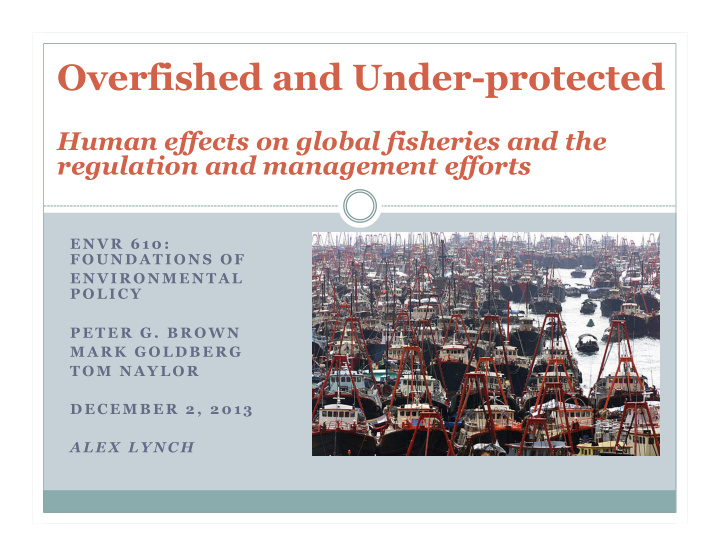



Overfished and Under-protected Human effects on global fisheries and the regulation and management efforts E N V R 6 1 0 : F O U N D A T I O N S O F E N V I R O N M E N T A L P O L I C Y P E T E R G . B R O W N M A R K G O L D B E R G T O M N A Y L O R D E C E M B E R 2 , 2 0 1 3 A L E X L Y N C H
Thomas Henry Huxley (1883) “The cod fishery, the herring fishery, the pilchard fishery, the mackerel fishery, and probably all the great fisheries, are inexhaustible: that is to say that nothing we do seriously affects the number of fish. And any attempt to regulate these fisheries seems consequently, from the nature of the case, to be useless” Source: Graham M., 1943
Significant Points in History Introduction of Trawling Sail was replaced by steam 18 th century powered vessels in 1880s Development of Factory Trawling The application of war technologies 1940s to fisheries Source: Holm P., 2012
Source: FAO 2005
Total Global Fishing Effort (1950–2010) Source: Anticamara et al, 2010
Food and Agriculture Organization: The Status of Fishery Resources 2010 15% low or moderately Comes from three data sources exploited 1) Biomass Estimates 53% fully exploited 2) Stock Status Reports 28% overexploited 3) Catch Data 3% depleted 1% recovering from depletion Limitations • Only represents 80% of global fish stocks • 13% -32% of global catch data is unreported • 8% of catch is discarded (no commercial value, over quotas) • Illegal fishing efforts unaccounted for Source FAO 2010
Factors of Changing Global Fish Stocks Overcapacity – Fishing Effort Institutional Framework Ecosystem Overfishing Alteration/Destruction of Marine Habitat Pollution Introduced Species Global Climate Change Ocean Acidification ¡ Coral Reef Collapse ¡
Overcapacity of the Global Fishing Industry Overcapacity , i.e. too many fishing boats for the volume of fish that can be caught 2.1 million powered fishing vessels around the world (FAO 2009) Needs to be cut by 40% to meet sustainable yield Consequences ¡ Excessive impacts on marine ecosystems ¡ Competition for limited resources Causes ¡ Government subsidies ¡ Lack of clearly defined property rights Source: (Watson et al., 2012)
Global Fishing Industry Subsidies As much as one-quarter of total industry revenue comes from subsidies ¡ Work Bank estimates $14-20 billion dollars annually Subsidies create fishing capacity ¡ Examples: Fuel subsidies, boat construction renewal, etc. Reduced fishing costs à Increase in profit à Incentive for participation à Overcapacity Source: Sumaila, 2003
Global Marine Fisheries Institutional Framework International Marine Organization ¡ Oversee safety of fishing vessels Food and Agriculture Organization and the World Bank ¡ Provide management advice ¡ Collect data Regional Fisheries Management Organizations
Regional Fisheries Management Organizations Exclusive Economic Zones • 200 Nautical Miles • Sovereign Rights 1) Manage fish stocks by region 2) Manage migratory fish species, mainly tuna Source: FAO, 2010
Limitations to Current Management Scheme Regional Fisheries Management Organizations ¡ 1) Regional whereas the problem is global ¡ 2) Only regulate fishing effort ¡ 3) Based on where the fish are, not the fishing effort ¡ 4) Compliance Fail to address overcapacity of the industry Can create overcapacity through the “Balloon Effect” Source: Barkin, J.S. et al. 2013
Rebuilding Global Fisheries Gear Restrictions Area Closures Catch Shares Subsidy Reduction Total Allowable Catch Reduced Reduction in Quotas Undermined by: ¡ Illegal and unreported catches ¡ Fishing effort shift to developing world Source: Worm et al., 2009
Conclusion sustain verb [<L. sub -, under + tenere , hold] 1. to keep in existence: maintain or prolong 2. to provide nourishment for 3. to support; carry the weight 4. to endure; withstand consume verb [<L. com -, together + sumere , take] 1. to destroy, as by fire 2. to use up (time, money etc.) 3. to eat or drink up Source: Gyenis A., 2004
References Anticamara J.A., Watson A., Gelchu D., Pauly, Global fishing effort (1950–2010): Trends, gaps, and implications, Fisheries Research Volume 107, Issues 1–3 2011 131 – 136, Retrieved from: http://dx.doi.org/10.1016/j.fishres.2010.10.016 Barkin S. J., 2013, International Fisheries Governance that Works: The Case for a Global Fisheries Organization, Governance and sustainability issue brief series, Retrieved from: http://cdn.umb.edu/images/centers_institutes/center_governance_sustain/Issue_8.pdf Food and Agriculture Organization, 2010, The State of the World Fisheries and Aquaculture, Retrieved from:http://www.nmfs.noaa.gov/aquaculture/docs/ aquaculture_docs/2010_fao_state_of_world_fish_aq.pdf Food and Agriculture Organization, 2007, Future Prospects for Fish and Fishery Products, Retrieved from: http://www.fao.org/docrep/010/ah947e/ ah947e00.HTM Graham M., The Fish Gate (London 1943), p 111; see also T. H. Huxley, “The Herring,” Nature (London), 1881. Gyenis, A., 2004, Sustainable Consumption, Retrieved from: http://www.wordsareimportant.com/sustainable.htm Holm, P., 2012, World War II and the Great Acceleration of North Atlantic Fisheries, Retrieved from: http://www.globalenvironment.it/holm.pdf National Oceanic and Atmospheric Administration, U.S. Exclusive Economic Zones, Retrieved from: http://www.afsc.noaa.gov/generalinfo/eez.htm Sumaila, U. R., 2003, A fish called Subsidy. Science and the Environment, 12(12). Online, available at: http://www.downtoearth.org.in/fullprint.asp. Last accessed August 25, 2006. Watson et al., 2012, Global marine yield halved as fishing intensity redoubles, Fish and Fisheries, Retrieved from http://www.seaaroundus.org/researcher/ dpauly/PDF/2012/JournalArticles/GlobalMarineYieldHalved.pdf Worm et al., 2009, Rebuilding Global Fisheries, Science, Retrieved from: http://wormlab.biology.dal.ca/ramweb/papers-total/Worm%20et%20al. %202009_Science.pdf
Thank You Source: SMH, 2009
Recommend
More recommend